Drug Abuse in Hispanic Community: Module 7 Final Paper Analysis
VerifiedAdded on 2022/08/08
|12
|3240
|35
Report
AI Summary
This report examines the public health issue of drug and alcohol abuse within the Hispanic community in the United States. It analyzes the problem, highlighting the higher rates of substance abuse among Hispanics compared to other racial groups, and explores the social, behavioral, and cultural factors contributing to this issue, including unemployment, language barriers, and cultural beliefs. The report provides an overview of initiatives, such as those by SAMHSA and PAHO, aimed at addressing the problem and reducing healthcare disparities. It applies the social cognitive theory to understand the behavioral aspects of the community and offers recommendations for community-level stakeholders, state agencies, and healthcare workers. The report emphasizes the need for increased awareness, language-appropriate healthcare, and employment opportunities to mitigate the problem and promote a healthier lifestyle among Hispanics.
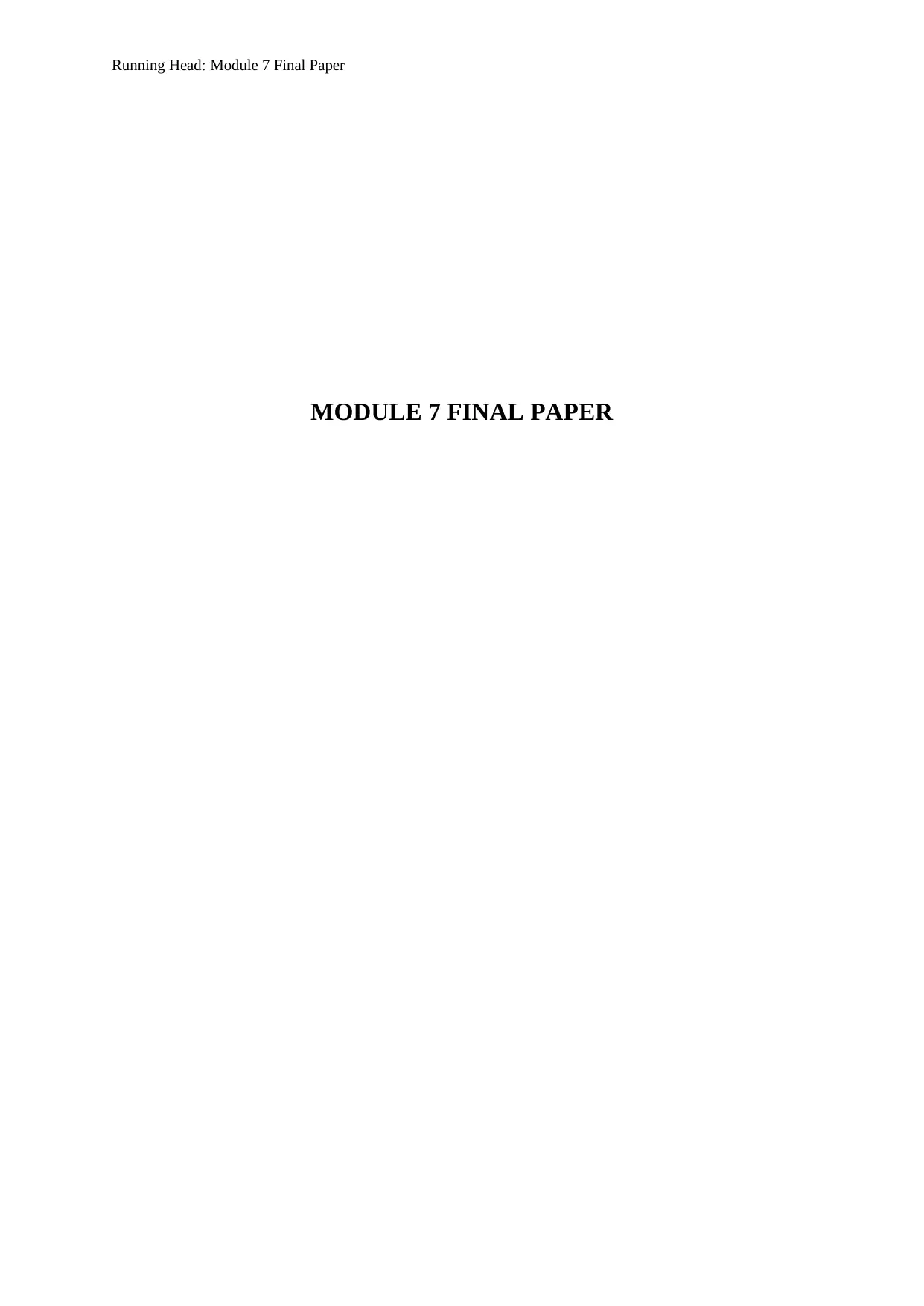
Running Head: Module 7 Final Paper
MODULE 7 FINAL PAPER
MODULE 7 FINAL PAPER
Paraphrase This Document
Need a fresh take? Get an instant paraphrase of this document with our AI Paraphraser
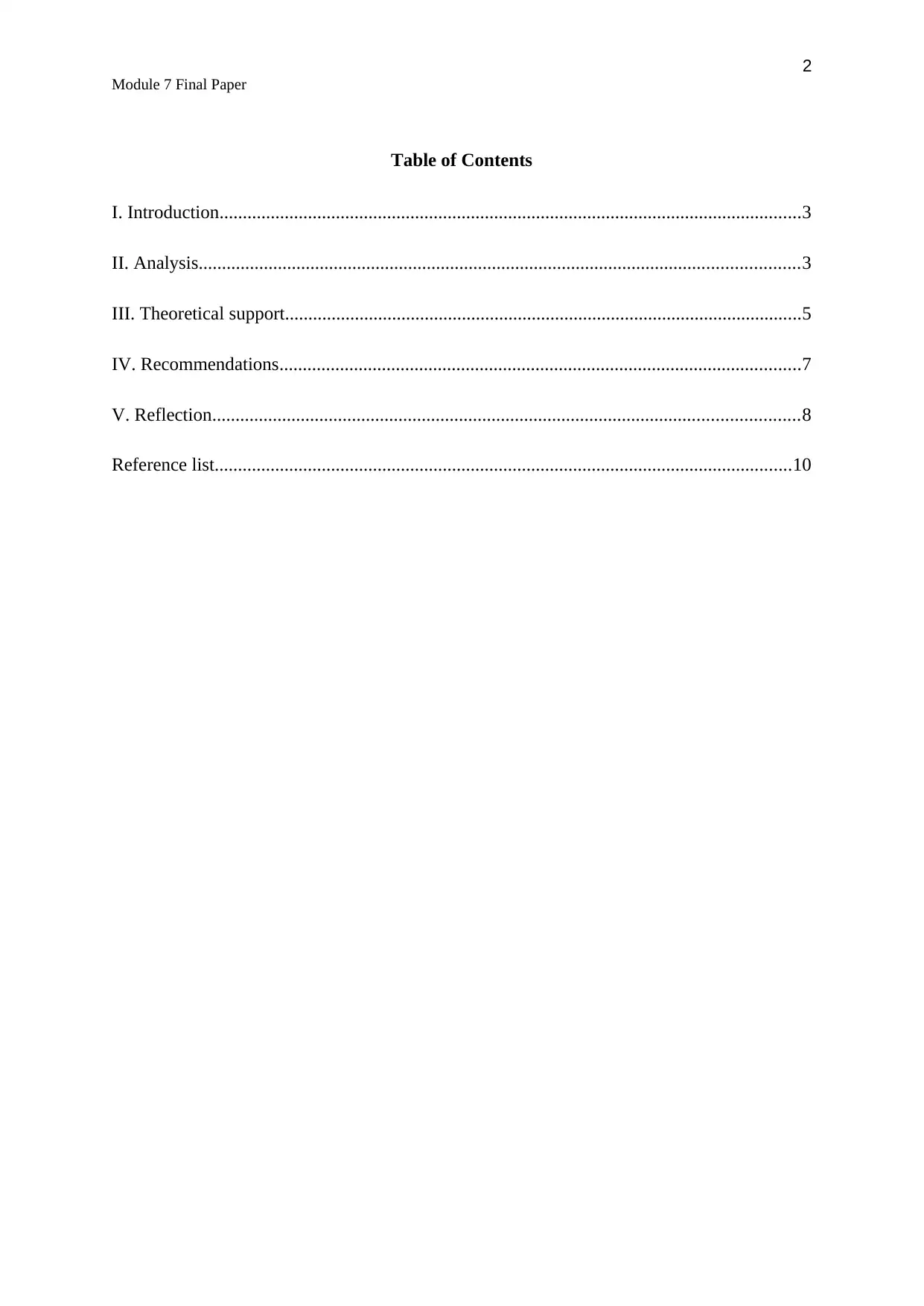
2
Module 7 Final Paper
Table of Contents
I. Introduction.............................................................................................................................3
II. Analysis.................................................................................................................................3
III. Theoretical support...............................................................................................................5
IV. Recommendations................................................................................................................7
V. Reflection..............................................................................................................................8
Reference list............................................................................................................................10
Module 7 Final Paper
Table of Contents
I. Introduction.............................................................................................................................3
II. Analysis.................................................................................................................................3
III. Theoretical support...............................................................................................................5
IV. Recommendations................................................................................................................7
V. Reflection..............................................................................................................................8
Reference list............................................................................................................................10
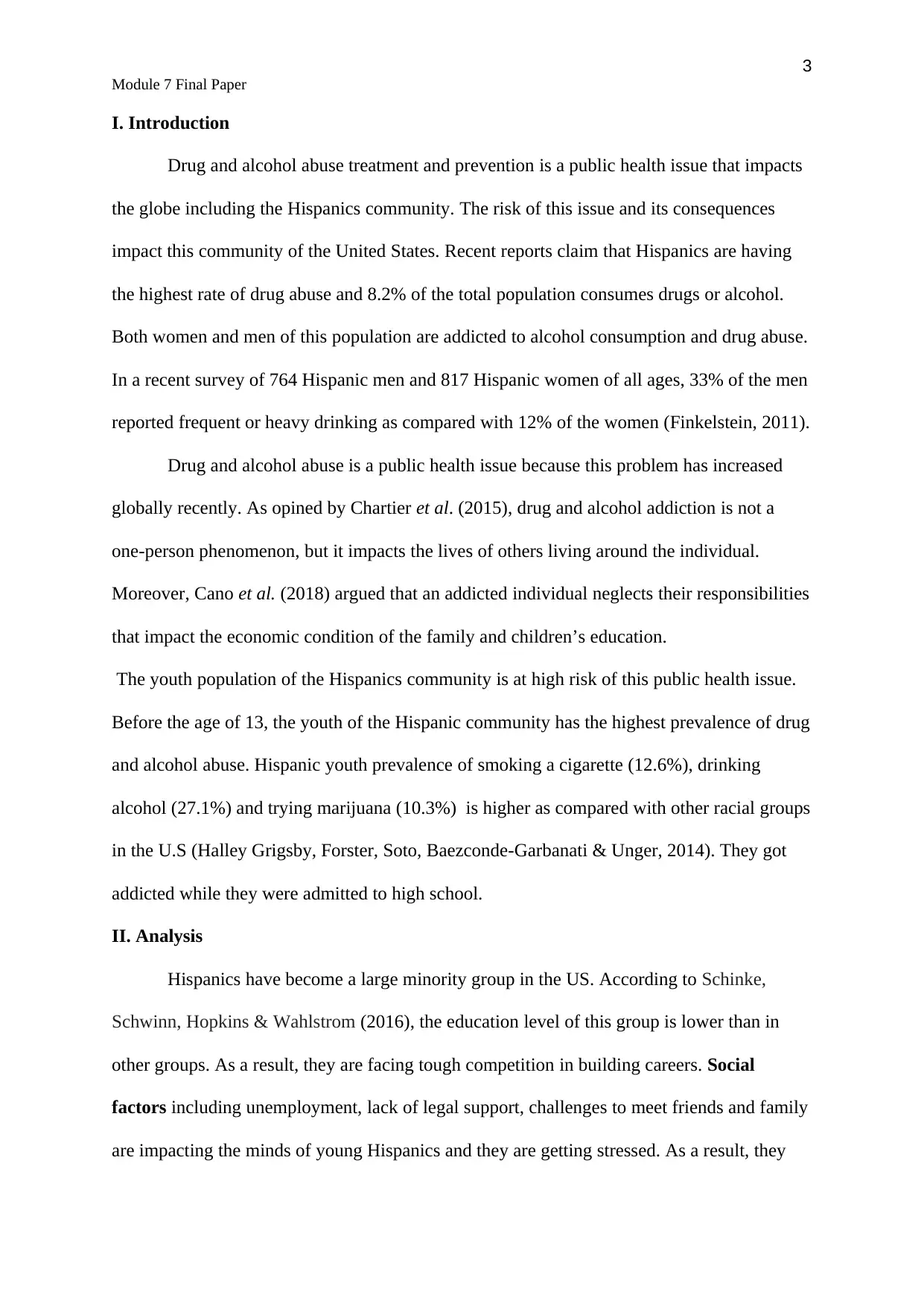
3
Module 7 Final Paper
I. Introduction
Drug and alcohol abuse treatment and prevention is a public health issue that impacts
the globe including the Hispanics community. The risk of this issue and its consequences
impact this community of the United States. Recent reports claim that Hispanics are having
the highest rate of drug abuse and 8.2% of the total population consumes drugs or alcohol.
Both women and men of this population are addicted to alcohol consumption and drug abuse.
In a recent survey of 764 Hispanic men and 817 Hispanic women of all ages, 33% of the men
reported frequent or heavy drinking as compared with 12% of the women (Finkelstein, 2011).
Drug and alcohol abuse is a public health issue because this problem has increased
globally recently. As opined by Chartier et al. (2015), drug and alcohol addiction is not a
one-person phenomenon, but it impacts the lives of others living around the individual.
Moreover, Cano et al. (2018) argued that an addicted individual neglects their responsibilities
that impact the economic condition of the family and children’s education.
The youth population of the Hispanics community is at high risk of this public health issue.
Before the age of 13, the youth of the Hispanic community has the highest prevalence of drug
and alcohol abuse. Hispanic youth prevalence of smoking a cigarette (12.6%), drinking
alcohol (27.1%) and trying marijuana (10.3%) is higher as compared with other racial groups
in the U.S (Halley Grigsby, Forster, Soto, Baezconde-Garbanati & Unger, 2014). They got
addicted while they were admitted to high school.
II. Analysis
Hispanics have become a large minority group in the US. According to Schinke,
Schwinn, Hopkins & Wahlstrom (2016), the education level of this group is lower than in
other groups. As a result, they are facing tough competition in building careers. Social
factors including unemployment, lack of legal support, challenges to meet friends and family
are impacting the minds of young Hispanics and they are getting stressed. As a result, they
Module 7 Final Paper
I. Introduction
Drug and alcohol abuse treatment and prevention is a public health issue that impacts
the globe including the Hispanics community. The risk of this issue and its consequences
impact this community of the United States. Recent reports claim that Hispanics are having
the highest rate of drug abuse and 8.2% of the total population consumes drugs or alcohol.
Both women and men of this population are addicted to alcohol consumption and drug abuse.
In a recent survey of 764 Hispanic men and 817 Hispanic women of all ages, 33% of the men
reported frequent or heavy drinking as compared with 12% of the women (Finkelstein, 2011).
Drug and alcohol abuse is a public health issue because this problem has increased
globally recently. As opined by Chartier et al. (2015), drug and alcohol addiction is not a
one-person phenomenon, but it impacts the lives of others living around the individual.
Moreover, Cano et al. (2018) argued that an addicted individual neglects their responsibilities
that impact the economic condition of the family and children’s education.
The youth population of the Hispanics community is at high risk of this public health issue.
Before the age of 13, the youth of the Hispanic community has the highest prevalence of drug
and alcohol abuse. Hispanic youth prevalence of smoking a cigarette (12.6%), drinking
alcohol (27.1%) and trying marijuana (10.3%) is higher as compared with other racial groups
in the U.S (Halley Grigsby, Forster, Soto, Baezconde-Garbanati & Unger, 2014). They got
addicted while they were admitted to high school.
II. Analysis
Hispanics have become a large minority group in the US. According to Schinke,
Schwinn, Hopkins & Wahlstrom (2016), the education level of this group is lower than in
other groups. As a result, they are facing tough competition in building careers. Social
factors including unemployment, lack of legal support, challenges to meet friends and family
are impacting the minds of young Hispanics and they are getting stressed. As a result, they
⊘ This is a preview!⊘
Do you want full access?
Subscribe today to unlock all pages.

Trusted by 1+ million students worldwide

4
Module 7 Final Paper
are getting drug abused and due to the language barrier, they are not getting enough health
support. Fortuna et al. (2016) have mentioned that Hispanics are less likely to be involved in
social activities. Behavioral factors such as reserved nature, being over formal and not
valuing time are related to drug abuse. These factors are preventing Hispanics to
communicate with other groups and they are unable to share their reasons for stress as well as
depression. Cultural factors including belief in only Roman Catholicism have prevented this
group from understanding other cultures (Chartier et al. 2015). As a result, they are also not
getting respect from the other groups of the society and getting depressed.
Pan American Health Organization (PAHO) has developed a substance abuse
program and the Substance Abuse and Mental Health Services Administration
(SAMHSA) helps Hispanics through their website in this regard (Samhsa.gov, 2020).
Alcoholics Anonymous has its own website in the Spanish language to help Hispanics from
drug abuse. On the other hand, Cano et al. (2018) have mentioned the Safe and Drug-Free
School and Communities Act 2002 and the Healthy People 2010 program that are helping
Hispanics from drug abuse.
The state-sponsored initiatives have a great impact on drug abuse prevention in the
US. Reportedly, the rate of drug abuse in Hispanics has been reduced compared to the
national average rate. As mentioned by Escobedo, Allem, Baezconde-Garbanati & Unger
(2018), cases of drug abuse in Hispanics have been found 6.6% in 2017. It means that people
of this group are being aware of the harmful effects of drugs and getting appropriate
healthcare support. On the other hand, Allem, Sussman, Soto, Baezconde-Garbanati & Unger
(2016) have mentioned that since 2010 the rate of use of marijuana by Hispanics has
remained steady at 3.4%. Additionally, it has been found that the rate of drug use was higher
in terms of US-born Hispanics than other Hispanics. After reviewing the decreasing rate of
Module 7 Final Paper
are getting drug abused and due to the language barrier, they are not getting enough health
support. Fortuna et al. (2016) have mentioned that Hispanics are less likely to be involved in
social activities. Behavioral factors such as reserved nature, being over formal and not
valuing time are related to drug abuse. These factors are preventing Hispanics to
communicate with other groups and they are unable to share their reasons for stress as well as
depression. Cultural factors including belief in only Roman Catholicism have prevented this
group from understanding other cultures (Chartier et al. 2015). As a result, they are also not
getting respect from the other groups of the society and getting depressed.
Pan American Health Organization (PAHO) has developed a substance abuse
program and the Substance Abuse and Mental Health Services Administration
(SAMHSA) helps Hispanics through their website in this regard (Samhsa.gov, 2020).
Alcoholics Anonymous has its own website in the Spanish language to help Hispanics from
drug abuse. On the other hand, Cano et al. (2018) have mentioned the Safe and Drug-Free
School and Communities Act 2002 and the Healthy People 2010 program that are helping
Hispanics from drug abuse.
The state-sponsored initiatives have a great impact on drug abuse prevention in the
US. Reportedly, the rate of drug abuse in Hispanics has been reduced compared to the
national average rate. As mentioned by Escobedo, Allem, Baezconde-Garbanati & Unger
(2018), cases of drug abuse in Hispanics have been found 6.6% in 2017. It means that people
of this group are being aware of the harmful effects of drugs and getting appropriate
healthcare support. On the other hand, Allem, Sussman, Soto, Baezconde-Garbanati & Unger
(2016) have mentioned that since 2010 the rate of use of marijuana by Hispanics has
remained steady at 3.4%. Additionally, it has been found that the rate of drug use was higher
in terms of US-born Hispanics than other Hispanics. After reviewing the decreasing rate of
Paraphrase This Document
Need a fresh take? Get an instant paraphrase of this document with our AI Paraphraser
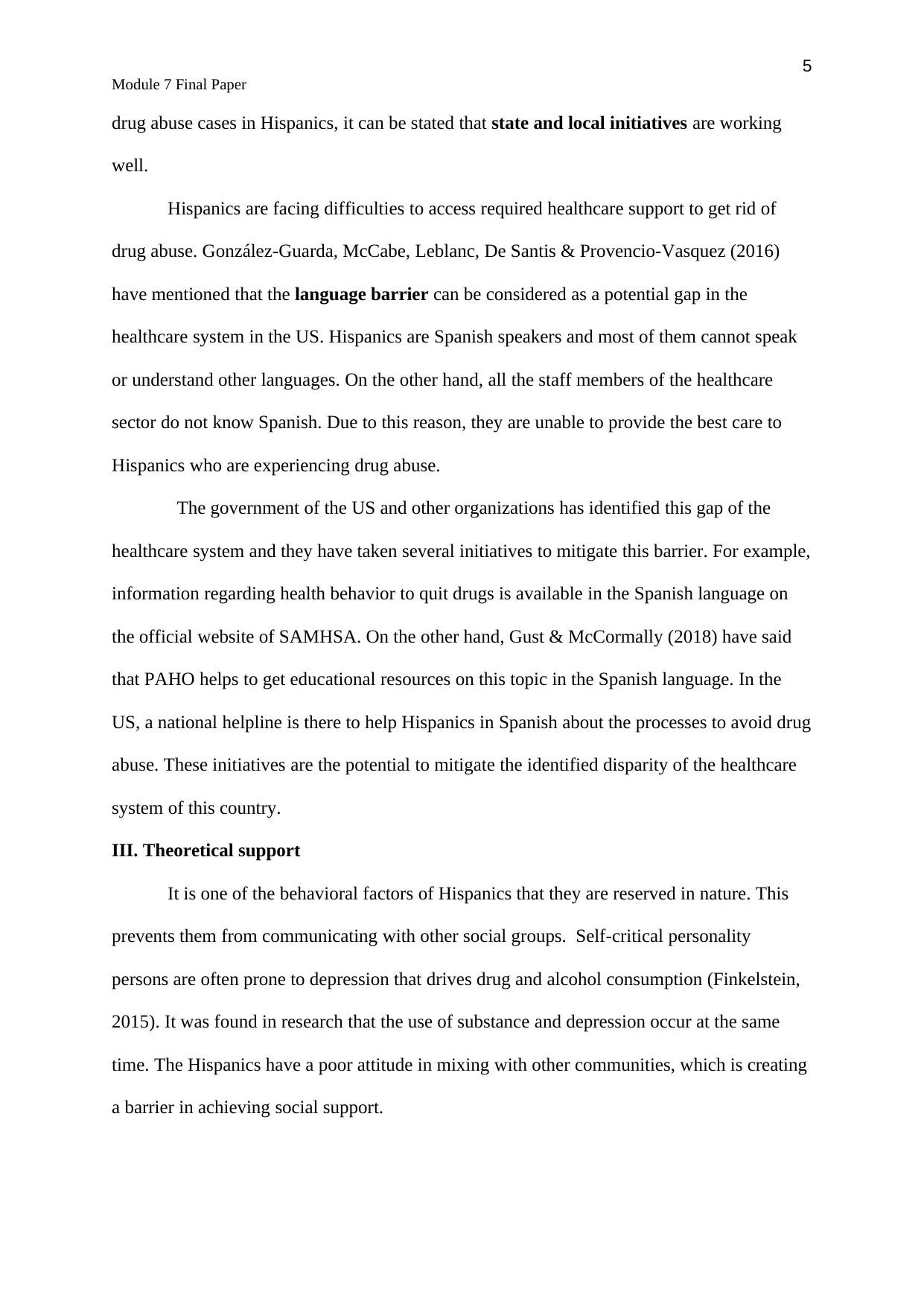
5
Module 7 Final Paper
drug abuse cases in Hispanics, it can be stated that state and local initiatives are working
well.
Hispanics are facing difficulties to access required healthcare support to get rid of
drug abuse. González-Guarda, McCabe, Leblanc, De Santis & Provencio-Vasquez (2016)
have mentioned that the language barrier can be considered as a potential gap in the
healthcare system in the US. Hispanics are Spanish speakers and most of them cannot speak
or understand other languages. On the other hand, all the staff members of the healthcare
sector do not know Spanish. Due to this reason, they are unable to provide the best care to
Hispanics who are experiencing drug abuse.
The government of the US and other organizations has identified this gap of the
healthcare system and they have taken several initiatives to mitigate this barrier. For example,
information regarding health behavior to quit drugs is available in the Spanish language on
the official website of SAMHSA. On the other hand, Gust & McCormally (2018) have said
that PAHO helps to get educational resources on this topic in the Spanish language. In the
US, a national helpline is there to help Hispanics in Spanish about the processes to avoid drug
abuse. These initiatives are the potential to mitigate the identified disparity of the healthcare
system of this country.
III. Theoretical support
It is one of the behavioral factors of Hispanics that they are reserved in nature. This
prevents them from communicating with other social groups. Self-critical personality
persons are often prone to depression that drives drug and alcohol consumption (Finkelstein,
2015). It was found in research that the use of substance and depression occur at the same
time. The Hispanics have a poor attitude in mixing with other communities, which is creating
a barrier in achieving social support.
Module 7 Final Paper
drug abuse cases in Hispanics, it can be stated that state and local initiatives are working
well.
Hispanics are facing difficulties to access required healthcare support to get rid of
drug abuse. González-Guarda, McCabe, Leblanc, De Santis & Provencio-Vasquez (2016)
have mentioned that the language barrier can be considered as a potential gap in the
healthcare system in the US. Hispanics are Spanish speakers and most of them cannot speak
or understand other languages. On the other hand, all the staff members of the healthcare
sector do not know Spanish. Due to this reason, they are unable to provide the best care to
Hispanics who are experiencing drug abuse.
The government of the US and other organizations has identified this gap of the
healthcare system and they have taken several initiatives to mitigate this barrier. For example,
information regarding health behavior to quit drugs is available in the Spanish language on
the official website of SAMHSA. On the other hand, Gust & McCormally (2018) have said
that PAHO helps to get educational resources on this topic in the Spanish language. In the
US, a national helpline is there to help Hispanics in Spanish about the processes to avoid drug
abuse. These initiatives are the potential to mitigate the identified disparity of the healthcare
system of this country.
III. Theoretical support
It is one of the behavioral factors of Hispanics that they are reserved in nature. This
prevents them from communicating with other social groups. Self-critical personality
persons are often prone to depression that drives drug and alcohol consumption (Finkelstein,
2015). It was found in research that the use of substance and depression occur at the same
time. The Hispanics have a poor attitude in mixing with other communities, which is creating
a barrier in achieving social support.
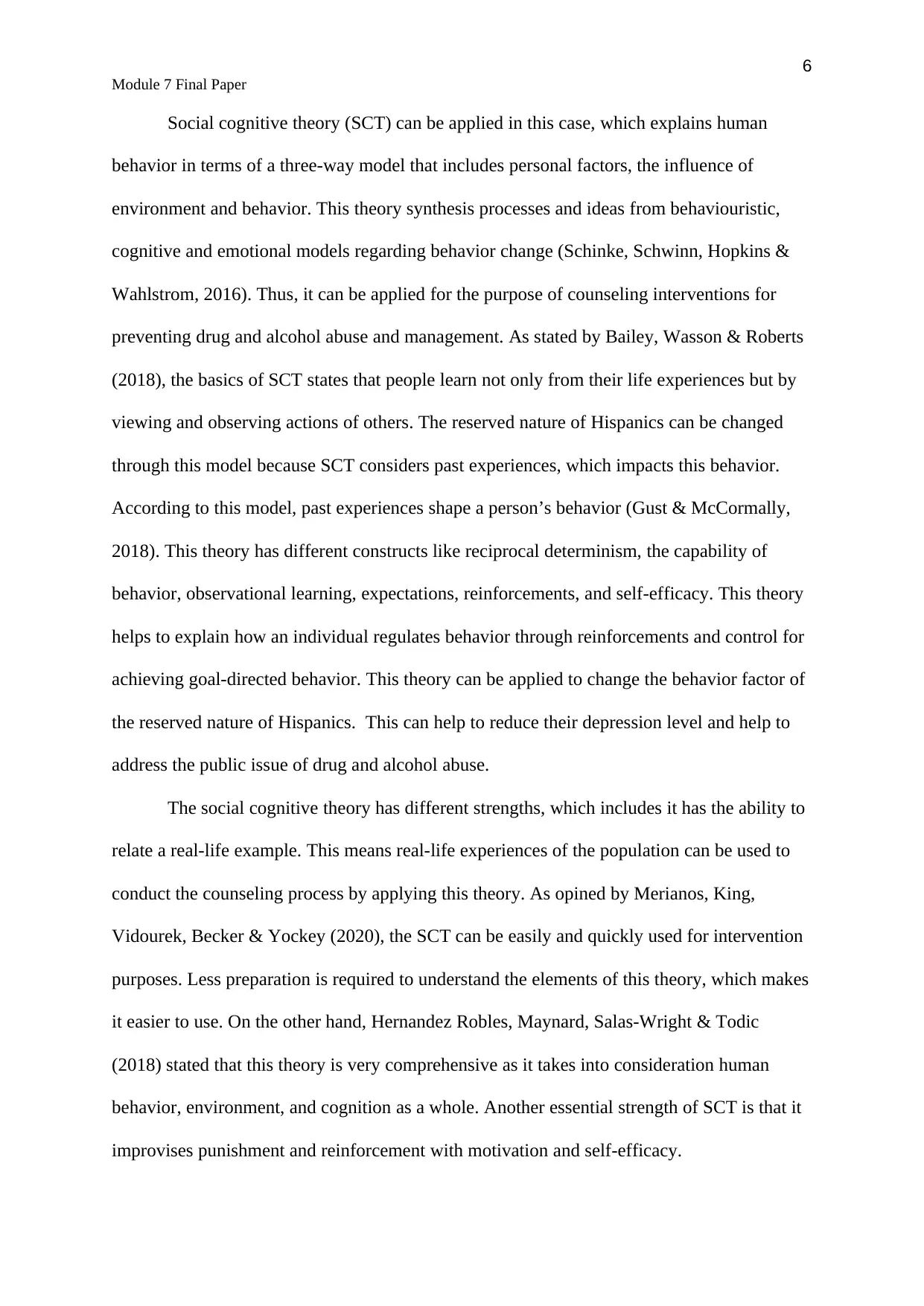
6
Module 7 Final Paper
Social cognitive theory (SCT) can be applied in this case, which explains human
behavior in terms of a three-way model that includes personal factors, the influence of
environment and behavior. This theory synthesis processes and ideas from behaviouristic,
cognitive and emotional models regarding behavior change (Schinke, Schwinn, Hopkins &
Wahlstrom, 2016). Thus, it can be applied for the purpose of counseling interventions for
preventing drug and alcohol abuse and management. As stated by Bailey, Wasson & Roberts
(2018), the basics of SCT states that people learn not only from their life experiences but by
viewing and observing actions of others. The reserved nature of Hispanics can be changed
through this model because SCT considers past experiences, which impacts this behavior.
According to this model, past experiences shape a person’s behavior (Gust & McCormally,
2018). This theory has different constructs like reciprocal determinism, the capability of
behavior, observational learning, expectations, reinforcements, and self-efficacy. This theory
helps to explain how an individual regulates behavior through reinforcements and control for
achieving goal-directed behavior. This theory can be applied to change the behavior factor of
the reserved nature of Hispanics. This can help to reduce their depression level and help to
address the public issue of drug and alcohol abuse.
The social cognitive theory has different strengths, which includes it has the ability to
relate a real-life example. This means real-life experiences of the population can be used to
conduct the counseling process by applying this theory. As opined by Merianos, King,
Vidourek, Becker & Yockey (2020), the SCT can be easily and quickly used for intervention
purposes. Less preparation is required to understand the elements of this theory, which makes
it easier to use. On the other hand, Hernandez Robles, Maynard, Salas-Wright & Todic
(2018) stated that this theory is very comprehensive as it takes into consideration human
behavior, environment, and cognition as a whole. Another essential strength of SCT is that it
improvises punishment and reinforcement with motivation and self-efficacy.
Module 7 Final Paper
Social cognitive theory (SCT) can be applied in this case, which explains human
behavior in terms of a three-way model that includes personal factors, the influence of
environment and behavior. This theory synthesis processes and ideas from behaviouristic,
cognitive and emotional models regarding behavior change (Schinke, Schwinn, Hopkins &
Wahlstrom, 2016). Thus, it can be applied for the purpose of counseling interventions for
preventing drug and alcohol abuse and management. As stated by Bailey, Wasson & Roberts
(2018), the basics of SCT states that people learn not only from their life experiences but by
viewing and observing actions of others. The reserved nature of Hispanics can be changed
through this model because SCT considers past experiences, which impacts this behavior.
According to this model, past experiences shape a person’s behavior (Gust & McCormally,
2018). This theory has different constructs like reciprocal determinism, the capability of
behavior, observational learning, expectations, reinforcements, and self-efficacy. This theory
helps to explain how an individual regulates behavior through reinforcements and control for
achieving goal-directed behavior. This theory can be applied to change the behavior factor of
the reserved nature of Hispanics. This can help to reduce their depression level and help to
address the public issue of drug and alcohol abuse.
The social cognitive theory has different strengths, which includes it has the ability to
relate a real-life example. This means real-life experiences of the population can be used to
conduct the counseling process by applying this theory. As opined by Merianos, King,
Vidourek, Becker & Yockey (2020), the SCT can be easily and quickly used for intervention
purposes. Less preparation is required to understand the elements of this theory, which makes
it easier to use. On the other hand, Hernandez Robles, Maynard, Salas-Wright & Todic
(2018) stated that this theory is very comprehensive as it takes into consideration human
behavior, environment, and cognition as a whole. Another essential strength of SCT is that it
improvises punishment and reinforcement with motivation and self-efficacy.
⊘ This is a preview!⊘
Do you want full access?
Subscribe today to unlock all pages.

Trusted by 1+ million students worldwide

7
Module 7 Final Paper
However, there are some limitations of this theory that includes this theory considers
that changes in the environment will induce a change in a person, which is not true (Cardoso,
Goldbach, Cervantes & Swank, 2016). For example, providing ample chance of interaction
cannot increase a person’s intention to communicate more with others. Moreover, this theory
is loosely organized and totally dependent upon the interplay between environment, person
and behavior. The actual behavior of these factors is totally unclear such as which factor is
more influential over others. In addition, SCT gives less stress to human emotions. However,
it is essential to understand the emotions of the target population before implementing
interventions.
IV. Recommendations
It can be recommended to different community-level stakeholders like residents,
school and college authorities and others to monitor and interact closely with Hispanic youths
who interact less. They must seek to change this negative behavior among youths and
motivate them to lead a healthy lifestyle (Halley Grigsby, Forster, Soto, Baezconde-Garbanati
& Unger, 2014). These community-level stakeholders form the environment of the selected
population. Thus, this recommendation can help the target population to gain continuous
support from the environment.
Different state agencies like Agency for Substance Abuse Policy, Virginia Office for
Substance Abuse and Prevention, need to promote the harmful impacts of depression that
arise from less interaction and communication with others. These campaigns can be
organized in social media because the majority of youths use this platform in the modern age
(Allem et al. 2016). The campaigns must include the advantages of interaction with the social
environment and drug education prevention.
Proper training needs to be given to healthcare workers who sometimes are unable to
provide proper care due to language barriers. Proper care can be provided by improving their
Module 7 Final Paper
However, there are some limitations of this theory that includes this theory considers
that changes in the environment will induce a change in a person, which is not true (Cardoso,
Goldbach, Cervantes & Swank, 2016). For example, providing ample chance of interaction
cannot increase a person’s intention to communicate more with others. Moreover, this theory
is loosely organized and totally dependent upon the interplay between environment, person
and behavior. The actual behavior of these factors is totally unclear such as which factor is
more influential over others. In addition, SCT gives less stress to human emotions. However,
it is essential to understand the emotions of the target population before implementing
interventions.
IV. Recommendations
It can be recommended to different community-level stakeholders like residents,
school and college authorities and others to monitor and interact closely with Hispanic youths
who interact less. They must seek to change this negative behavior among youths and
motivate them to lead a healthy lifestyle (Halley Grigsby, Forster, Soto, Baezconde-Garbanati
& Unger, 2014). These community-level stakeholders form the environment of the selected
population. Thus, this recommendation can help the target population to gain continuous
support from the environment.
Different state agencies like Agency for Substance Abuse Policy, Virginia Office for
Substance Abuse and Prevention, need to promote the harmful impacts of depression that
arise from less interaction and communication with others. These campaigns can be
organized in social media because the majority of youths use this platform in the modern age
(Allem et al. 2016). The campaigns must include the advantages of interaction with the social
environment and drug education prevention.
Proper training needs to be given to healthcare workers who sometimes are unable to
provide proper care due to language barriers. Proper care can be provided by improving their
Paraphrase This Document
Need a fresh take? Get an instant paraphrase of this document with our AI Paraphraser
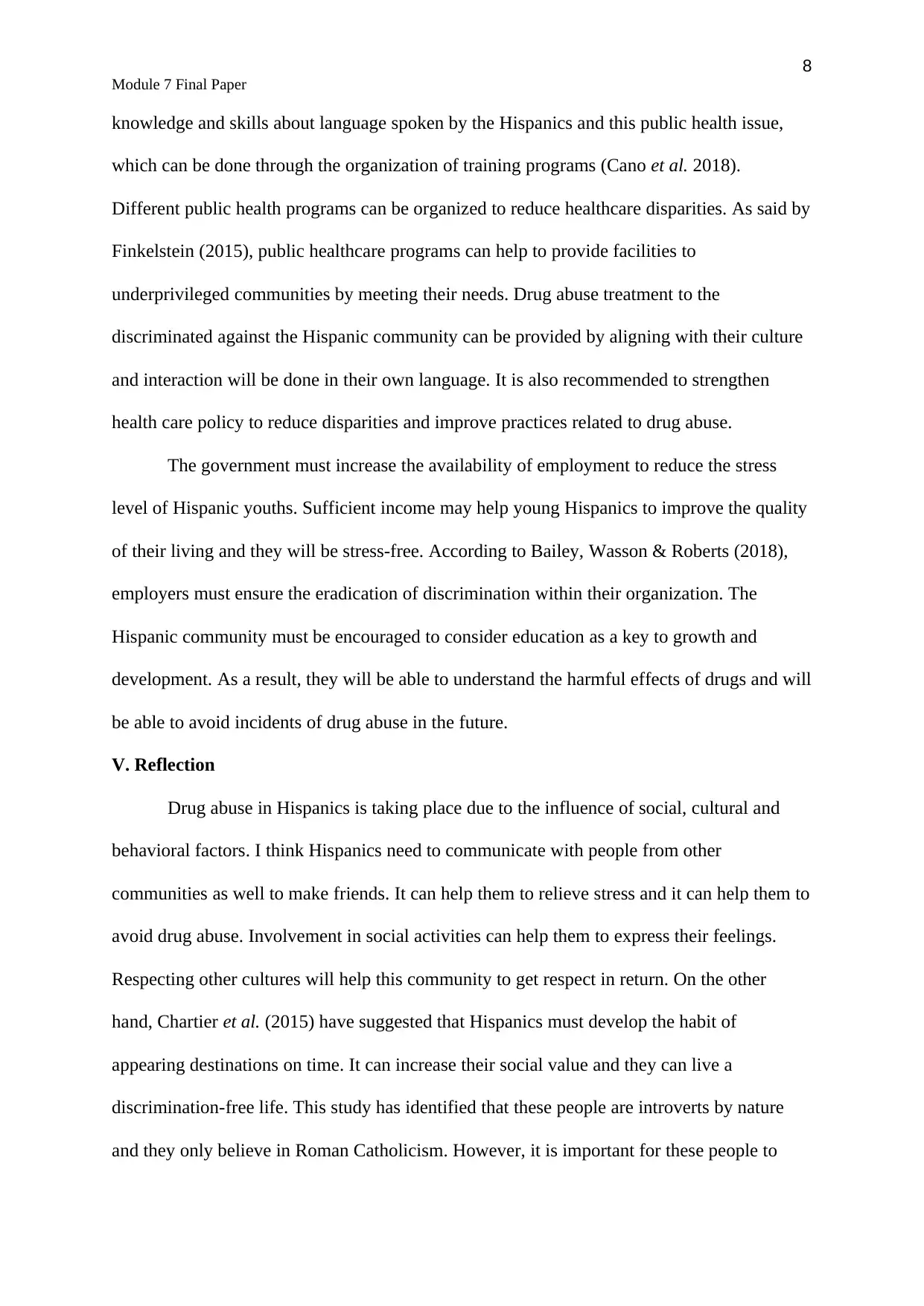
8
Module 7 Final Paper
knowledge and skills about language spoken by the Hispanics and this public health issue,
which can be done through the organization of training programs (Cano et al. 2018).
Different public health programs can be organized to reduce healthcare disparities. As said by
Finkelstein (2015), public healthcare programs can help to provide facilities to
underprivileged communities by meeting their needs. Drug abuse treatment to the
discriminated against the Hispanic community can be provided by aligning with their culture
and interaction will be done in their own language. It is also recommended to strengthen
health care policy to reduce disparities and improve practices related to drug abuse.
The government must increase the availability of employment to reduce the stress
level of Hispanic youths. Sufficient income may help young Hispanics to improve the quality
of their living and they will be stress-free. According to Bailey, Wasson & Roberts (2018),
employers must ensure the eradication of discrimination within their organization. The
Hispanic community must be encouraged to consider education as a key to growth and
development. As a result, they will be able to understand the harmful effects of drugs and will
be able to avoid incidents of drug abuse in the future.
V. Reflection
Drug abuse in Hispanics is taking place due to the influence of social, cultural and
behavioral factors. I think Hispanics need to communicate with people from other
communities as well to make friends. It can help them to relieve stress and it can help them to
avoid drug abuse. Involvement in social activities can help them to express their feelings.
Respecting other cultures will help this community to get respect in return. On the other
hand, Chartier et al. (2015) have suggested that Hispanics must develop the habit of
appearing destinations on time. It can increase their social value and they can live a
discrimination-free life. This study has identified that these people are introverts by nature
and they only believe in Roman Catholicism. However, it is important for these people to
Module 7 Final Paper
knowledge and skills about language spoken by the Hispanics and this public health issue,
which can be done through the organization of training programs (Cano et al. 2018).
Different public health programs can be organized to reduce healthcare disparities. As said by
Finkelstein (2015), public healthcare programs can help to provide facilities to
underprivileged communities by meeting their needs. Drug abuse treatment to the
discriminated against the Hispanic community can be provided by aligning with their culture
and interaction will be done in their own language. It is also recommended to strengthen
health care policy to reduce disparities and improve practices related to drug abuse.
The government must increase the availability of employment to reduce the stress
level of Hispanic youths. Sufficient income may help young Hispanics to improve the quality
of their living and they will be stress-free. According to Bailey, Wasson & Roberts (2018),
employers must ensure the eradication of discrimination within their organization. The
Hispanic community must be encouraged to consider education as a key to growth and
development. As a result, they will be able to understand the harmful effects of drugs and will
be able to avoid incidents of drug abuse in the future.
V. Reflection
Drug abuse in Hispanics is taking place due to the influence of social, cultural and
behavioral factors. I think Hispanics need to communicate with people from other
communities as well to make friends. It can help them to relieve stress and it can help them to
avoid drug abuse. Involvement in social activities can help them to express their feelings.
Respecting other cultures will help this community to get respect in return. On the other
hand, Chartier et al. (2015) have suggested that Hispanics must develop the habit of
appearing destinations on time. It can increase their social value and they can live a
discrimination-free life. This study has identified that these people are introverts by nature
and they only believe in Roman Catholicism. However, it is important for these people to

9
Module 7 Final Paper
show a positive attitude to others to get their support in preventing drug abuse. I think they
need to learn other languages like English to get the required healthcare support in this
regard.
Interaction with Hispanics may motivate them to share their agony and stress. The
recommendation of spreading awareness about the harmful effects of drugs can help them to
avoid using drugs. On the other hand, if healthcare professionals can communicate with them
in Spanish, they may be motivated to learn other languages as well for making the
relationship stronger. Improvement of the living standard with sufficient income can help
these people to show positive behavior to others and live life without daily stressors.
Additionally, the recommendation of encouraging them to be educated, cam help them to
develop self-awareness about the drawbacks of drug abuse.
Module 7 Final Paper
show a positive attitude to others to get their support in preventing drug abuse. I think they
need to learn other languages like English to get the required healthcare support in this
regard.
Interaction with Hispanics may motivate them to share their agony and stress. The
recommendation of spreading awareness about the harmful effects of drugs can help them to
avoid using drugs. On the other hand, if healthcare professionals can communicate with them
in Spanish, they may be motivated to learn other languages as well for making the
relationship stronger. Improvement of the living standard with sufficient income can help
these people to show positive behavior to others and live life without daily stressors.
Additionally, the recommendation of encouraging them to be educated, cam help them to
develop self-awareness about the drawbacks of drug abuse.
⊘ This is a preview!⊘
Do you want full access?
Subscribe today to unlock all pages.

Trusted by 1+ million students worldwide

10
Module 7 Final Paper
Reference list
Allem, J. P., Sussman, S., Soto, D. W., Baezconde-Garbanati, L., & Unger, J. B. (2016). Role
transitions and substance use among Hispanic emerging adults: a longitudinal study
using coarsened exact matching. Addictive behaviors, 58, 95-99. Retrieved from:
https://www.ncbi.nlm.nih.gov/pmc/articles/PMC4808344/
Bailey, M. L., Wasson, S., & Roberts, B. (2018). Increasing Awareness of Substance Abuse
and Addictions: Does Early Childhood Drug Education Provide Diversion from Using
Drugs and/or Alcohol?. IU Journal of Undergraduate Research, 4(1), 107-112.
Retrieved from:
https://scholarworks.iu.edu/journals/index.php/iujur/article/download/24553/32032/
Cano, M. Á., Sánchez, M., Rojas, P., Ramírez-Ortiz, D., Polo, K. L., Romano, E., & De La
Rosa, M. (2018). Alcohol use severity among adult hispanic immigrants: Examining
the roles of family cohesion, social support, and gender. Substance use & misuse,
53(4), 668-676. Retrieved from:
https://www.ncbi.nlm.nih.gov/pmc/articles/PMC5820212/
Cardoso, J. B., Goldbach, J. T., Cervantes, R. C., & Swank, P. (2016). Stress and multiple
substance use behaviors among Hispanic adolescents. Prevention science, 17(2), 208-
217. Retrieved from: https://www.ncbi.nlm.nih.gov/pmc/articles/PMC4928676/
Chartier, K. G., Carmody, T., Akhtar, M., Stebbins, M. B., Walters, S. T., & Warden, D.
(2015). Hispanic subgroups, acculturation, and substance abuse treatment outcomes.
Journal of substance abuse treatment, 59, 74-82. Retrieved from:
https://www.ncbi.nlm.nih.gov/pmc/articles/PMC4661119/
Escobedo, P., Allem, J. P., Baezconde-Garbanati, L., & Unger, J. B. (2018). Cultural values
associated with substance use among Hispanic emerging adults in Southern
Module 7 Final Paper
Reference list
Allem, J. P., Sussman, S., Soto, D. W., Baezconde-Garbanati, L., & Unger, J. B. (2016). Role
transitions and substance use among Hispanic emerging adults: a longitudinal study
using coarsened exact matching. Addictive behaviors, 58, 95-99. Retrieved from:
https://www.ncbi.nlm.nih.gov/pmc/articles/PMC4808344/
Bailey, M. L., Wasson, S., & Roberts, B. (2018). Increasing Awareness of Substance Abuse
and Addictions: Does Early Childhood Drug Education Provide Diversion from Using
Drugs and/or Alcohol?. IU Journal of Undergraduate Research, 4(1), 107-112.
Retrieved from:
https://scholarworks.iu.edu/journals/index.php/iujur/article/download/24553/32032/
Cano, M. Á., Sánchez, M., Rojas, P., Ramírez-Ortiz, D., Polo, K. L., Romano, E., & De La
Rosa, M. (2018). Alcohol use severity among adult hispanic immigrants: Examining
the roles of family cohesion, social support, and gender. Substance use & misuse,
53(4), 668-676. Retrieved from:
https://www.ncbi.nlm.nih.gov/pmc/articles/PMC5820212/
Cardoso, J. B., Goldbach, J. T., Cervantes, R. C., & Swank, P. (2016). Stress and multiple
substance use behaviors among Hispanic adolescents. Prevention science, 17(2), 208-
217. Retrieved from: https://www.ncbi.nlm.nih.gov/pmc/articles/PMC4928676/
Chartier, K. G., Carmody, T., Akhtar, M., Stebbins, M. B., Walters, S. T., & Warden, D.
(2015). Hispanic subgroups, acculturation, and substance abuse treatment outcomes.
Journal of substance abuse treatment, 59, 74-82. Retrieved from:
https://www.ncbi.nlm.nih.gov/pmc/articles/PMC4661119/
Escobedo, P., Allem, J. P., Baezconde-Garbanati, L., & Unger, J. B. (2018). Cultural values
associated with substance use among Hispanic emerging adults in Southern
Paraphrase This Document
Need a fresh take? Get an instant paraphrase of this document with our AI Paraphraser
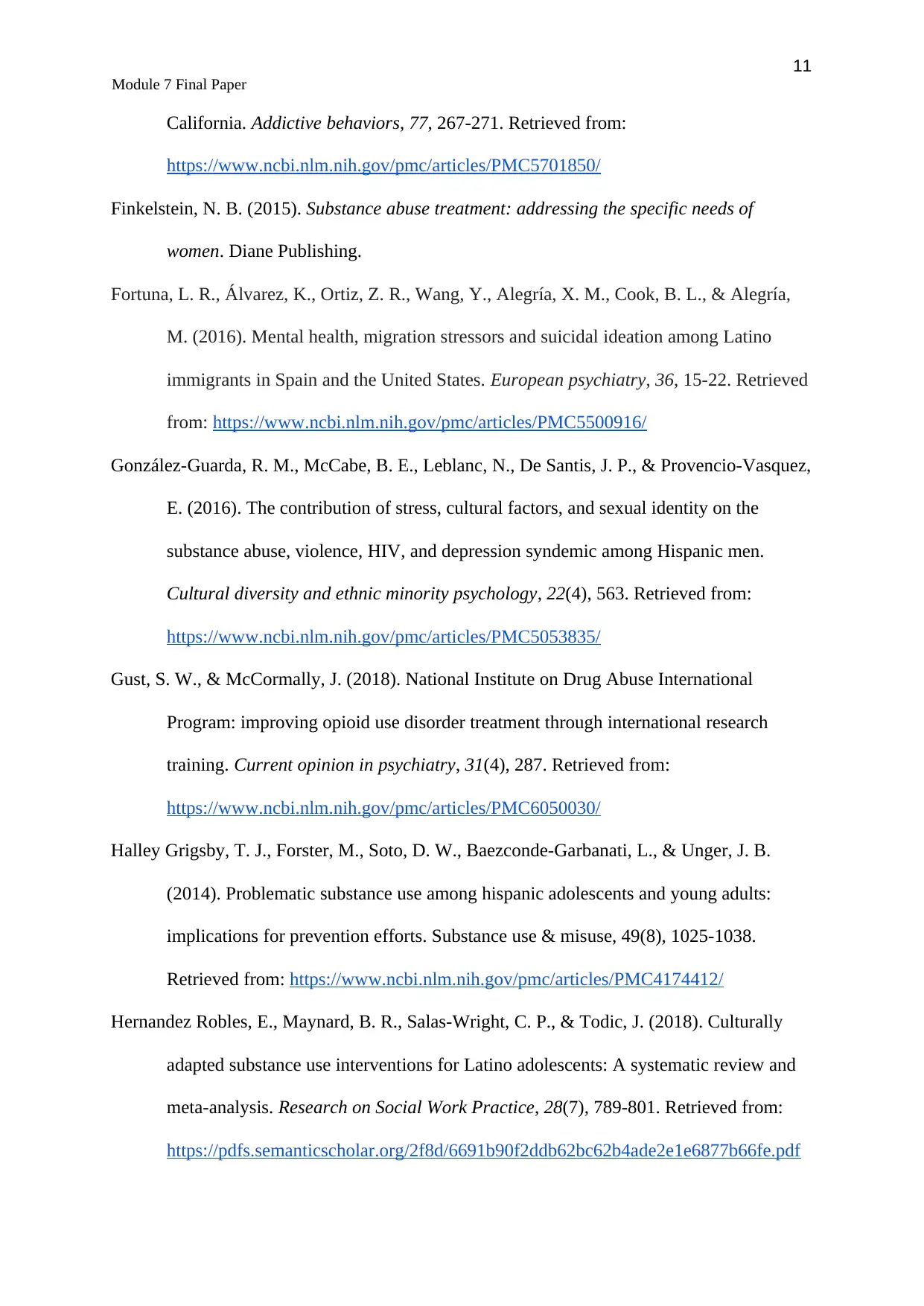
11
Module 7 Final Paper
California. Addictive behaviors, 77, 267-271. Retrieved from:
https://www.ncbi.nlm.nih.gov/pmc/articles/PMC5701850/
Finkelstein, N. B. (2015). Substance abuse treatment: addressing the specific needs of
women. Diane Publishing.
Fortuna, L. R., Álvarez, K., Ortiz, Z. R., Wang, Y., Alegría, X. M., Cook, B. L., & Alegría,
M. (2016). Mental health, migration stressors and suicidal ideation among Latino
immigrants in Spain and the United States. European psychiatry, 36, 15-22. Retrieved
from: https://www.ncbi.nlm.nih.gov/pmc/articles/PMC5500916/
González-Guarda, R. M., McCabe, B. E., Leblanc, N., De Santis, J. P., & Provencio-Vasquez,
E. (2016). The contribution of stress, cultural factors, and sexual identity on the
substance abuse, violence, HIV, and depression syndemic among Hispanic men.
Cultural diversity and ethnic minority psychology, 22(4), 563. Retrieved from:
https://www.ncbi.nlm.nih.gov/pmc/articles/PMC5053835/
Gust, S. W., & McCormally, J. (2018). National Institute on Drug Abuse International
Program: improving opioid use disorder treatment through international research
training. Current opinion in psychiatry, 31(4), 287. Retrieved from:
https://www.ncbi.nlm.nih.gov/pmc/articles/PMC6050030/
Halley Grigsby, T. J., Forster, M., Soto, D. W., Baezconde-Garbanati, L., & Unger, J. B.
(2014). Problematic substance use among hispanic adolescents and young adults:
implications for prevention efforts. Substance use & misuse, 49(8), 1025-1038.
Retrieved from: https://www.ncbi.nlm.nih.gov/pmc/articles/PMC4174412/
Hernandez Robles, E., Maynard, B. R., Salas-Wright, C. P., & Todic, J. (2018). Culturally
adapted substance use interventions for Latino adolescents: A systematic review and
meta-analysis. Research on Social Work Practice, 28(7), 789-801. Retrieved from:
https://pdfs.semanticscholar.org/2f8d/6691b90f2ddb62bc62b4ade2e1e6877b66fe.pdf
Module 7 Final Paper
California. Addictive behaviors, 77, 267-271. Retrieved from:
https://www.ncbi.nlm.nih.gov/pmc/articles/PMC5701850/
Finkelstein, N. B. (2015). Substance abuse treatment: addressing the specific needs of
women. Diane Publishing.
Fortuna, L. R., Álvarez, K., Ortiz, Z. R., Wang, Y., Alegría, X. M., Cook, B. L., & Alegría,
M. (2016). Mental health, migration stressors and suicidal ideation among Latino
immigrants in Spain and the United States. European psychiatry, 36, 15-22. Retrieved
from: https://www.ncbi.nlm.nih.gov/pmc/articles/PMC5500916/
González-Guarda, R. M., McCabe, B. E., Leblanc, N., De Santis, J. P., & Provencio-Vasquez,
E. (2016). The contribution of stress, cultural factors, and sexual identity on the
substance abuse, violence, HIV, and depression syndemic among Hispanic men.
Cultural diversity and ethnic minority psychology, 22(4), 563. Retrieved from:
https://www.ncbi.nlm.nih.gov/pmc/articles/PMC5053835/
Gust, S. W., & McCormally, J. (2018). National Institute on Drug Abuse International
Program: improving opioid use disorder treatment through international research
training. Current opinion in psychiatry, 31(4), 287. Retrieved from:
https://www.ncbi.nlm.nih.gov/pmc/articles/PMC6050030/
Halley Grigsby, T. J., Forster, M., Soto, D. W., Baezconde-Garbanati, L., & Unger, J. B.
(2014). Problematic substance use among hispanic adolescents and young adults:
implications for prevention efforts. Substance use & misuse, 49(8), 1025-1038.
Retrieved from: https://www.ncbi.nlm.nih.gov/pmc/articles/PMC4174412/
Hernandez Robles, E., Maynard, B. R., Salas-Wright, C. P., & Todic, J. (2018). Culturally
adapted substance use interventions for Latino adolescents: A systematic review and
meta-analysis. Research on Social Work Practice, 28(7), 789-801. Retrieved from:
https://pdfs.semanticscholar.org/2f8d/6691b90f2ddb62bc62b4ade2e1e6877b66fe.pdf

12
Module 7 Final Paper
Merianos, A. L., King, K. A., Vidourek, R. A., Becker, K. J., & Yockey, R. A. (2020).
Authoritative Parenting Behaviors and Marijuana Use Based on Age Among a
National Sample of Hispanic Adolescents. The Journal of Primary Prevention, 1-19.
Retrieved from:
https://www.researchgate.net/profile/Andrew_Yockey/publication/338565885_Author
itative_Parenting_Behaviors_and_Marijuana_Use_Based_on_Age_Among_a_Nation
al_Sample_of_Hispanic_Adolescents/links/5e1dadfc92851c1dcd388061/
Authoritative-Parenting-Behaviors-and-Marijuana-Use-Based-on-Age-Among-a-
National-Sample-of-Hispanic-Adolescents.pdf
Samhsa.gov. (2020). U.S. Department of Health & Human Services. Retrieved on 18th
February 2020, from: https://www.samhsa.gov/
Schinke, S., Schwinn, T., Hopkins, J., & Wahlstrom, L. (2016). Drug abuse risk and
protective factors among Hispanic adolescents. Preventive medicine reports, 3, 185-
188. Retrieved from:
https://www.sciencedirect.com/science/article/pii/S2211335516000152
Schinke, S., Schwinn, T., Hopkins, J., & Wahlstrom, L. (2016). Drug abuse risk and
protective factors among Hispanic adolescents. Preventive medicine reports, 3, 185-
188. Retrieved from:
https://www.sciencedirect.com/science/article/pii/S2211335516000152
Module 7 Final Paper
Merianos, A. L., King, K. A., Vidourek, R. A., Becker, K. J., & Yockey, R. A. (2020).
Authoritative Parenting Behaviors and Marijuana Use Based on Age Among a
National Sample of Hispanic Adolescents. The Journal of Primary Prevention, 1-19.
Retrieved from:
https://www.researchgate.net/profile/Andrew_Yockey/publication/338565885_Author
itative_Parenting_Behaviors_and_Marijuana_Use_Based_on_Age_Among_a_Nation
al_Sample_of_Hispanic_Adolescents/links/5e1dadfc92851c1dcd388061/
Authoritative-Parenting-Behaviors-and-Marijuana-Use-Based-on-Age-Among-a-
National-Sample-of-Hispanic-Adolescents.pdf
Samhsa.gov. (2020). U.S. Department of Health & Human Services. Retrieved on 18th
February 2020, from: https://www.samhsa.gov/
Schinke, S., Schwinn, T., Hopkins, J., & Wahlstrom, L. (2016). Drug abuse risk and
protective factors among Hispanic adolescents. Preventive medicine reports, 3, 185-
188. Retrieved from:
https://www.sciencedirect.com/science/article/pii/S2211335516000152
Schinke, S., Schwinn, T., Hopkins, J., & Wahlstrom, L. (2016). Drug abuse risk and
protective factors among Hispanic adolescents. Preventive medicine reports, 3, 185-
188. Retrieved from:
https://www.sciencedirect.com/science/article/pii/S2211335516000152
⊘ This is a preview!⊘
Do you want full access?
Subscribe today to unlock all pages.

Trusted by 1+ million students worldwide
1 out of 12
Related Documents
Your All-in-One AI-Powered Toolkit for Academic Success.
+13062052269
info@desklib.com
Available 24*7 on WhatsApp / Email
![[object Object]](/_next/static/media/star-bottom.7253800d.svg)
Unlock your academic potential
Copyright © 2020–2025 A2Z Services. All Rights Reserved. Developed and managed by ZUCOL.




